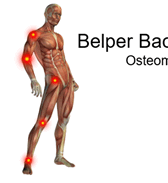 |
MOBILISATION
It has long been known that a passive movement, (i.e. movement of a joint, operated by someone else) of certain injured joint muscles, can be a relatively painless way to encourage a joint and the muscles of that joint to become more mobile. If performed by a qualified professional in a correct and gentle way, after first loosening the surrounding tissues by massage, can help restore the full range of movement to the area faster and easier than some other forms of treatment.
As the relaxed muscles are slowly and gently eased through the natural range of movement certain things are brought into play. The muscle begins to stretch the fibres that have been holding together trying to perform a protective spasm to stop the joint from further injury. The muscle begins to take on more nutrition and expel the toxins and waste products that have been building up because of the fibre's spasm.
The tendons are then able to move and regain their mobility and the ligaments of the joint can take on the job of allowing the joint to move again and stop any calcification building up around them. It also allows the body to make synovial fluid (in synovial joints) to "lubricate" the joint as this fluid may be lost because of the injury.
There is also a psychological and physiological barrier that can be broken down when it is seen by the patient that the joint can be moved without the normally accompanying pain- albeit that the moovement is being performed by the practitioner.
During Mobilsation is it quite normal to hear audible “clicks.” This is normal and is generally release of the tendons and or ligaments that have been under strain by their relative muscles being tight or in spasm, they can relax and return to their natural position. It is also possible to be the breaking down of small crystallisations or adhesions in the fascia of the muscles, referred to as crepitus. This is not to be confused to the “click” of a joint or vertebral adjustment which is a different sound and also there would be a loosening of the joint itself. It is possible a joint may be realigned during mobilisation. If the muscle is tight and pulling the joint out of its natural setting, this is a natural effect of muscles relaxing and should not cause any concern. If you have any concerns please mention it to the practitioner at the time. Do not wait until the next day or the next appointment.


